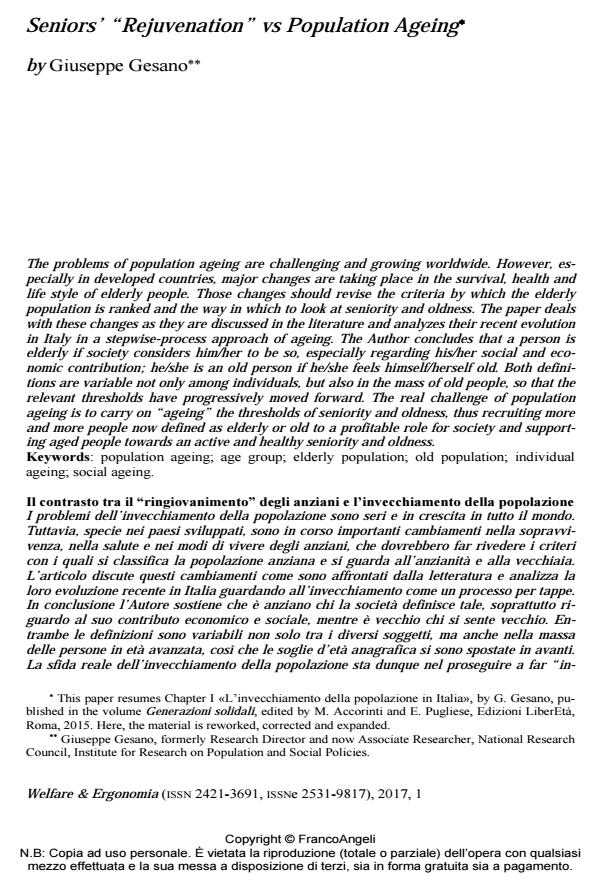Seniors’ "Rejuvenation" vs Population Ageing
Titolo Rivista WELFARE E ERGONOMIA
Autori/Curatori Giuseppe Gesano
Anno di pubblicazione 2018 Fascicolo 2017/1
Lingua Inglese Numero pagine 16 P. 47-62 Dimensione file 240 KB
DOI 10.3280/WE2017-001003
Il DOI è il codice a barre della proprietà intellettuale: per saperne di più
clicca qui
Qui sotto puoi vedere in anteprima la prima pagina di questo articolo.
Se questo articolo ti interessa, lo puoi acquistare (e scaricare in formato pdf) seguendo le facili indicazioni per acquistare il download credit. Acquista Download Credits per scaricare questo Articolo in formato PDF

FrancoAngeli è membro della Publishers International Linking Association, Inc (PILA)associazione indipendente e non profit per facilitare (attraverso i servizi tecnologici implementati da CrossRef.org) l’accesso degli studiosi ai contenuti digitali nelle pubblicazioni professionali e scientifiche
The problems of population ageing are challenging and growing worldwide. However, es-pecially in developed countries, major changes are taking place in the survival, health and life style of elderly people. Those changes should revise the criteria by which the elderly population is ranked and the way in which to look at seniority and oldness. The paper deals with these changes as they are discussed in the literature and analyzes their recent evolution in Italy in a stepwise-process approach of ageing. The Author concludes that a person is elderly if society considers him/her to be so, especially regarding his/her social and economic contribution; he/she is an old person if he/she feels himself/herself old. Both definitions are variable not only among individuals, but also in the mass of old people, so that the relevant thresholds have progressively moved forward. The real challenge of population ageing is to carry on "ageing" the thresholds of seniority and oldness, thus recruiting more and more people now defined as elderly or old to a profitable role for society and supporting aged people towards an active and healthy seniority and oldness.
I problemi dell’invecchiamento della popolazione sono seri e in crescita in tutto il mondo. Tuttavia, specie nei paesi sviluppati, sono in corso importanti cambiamenti nella sopravvi-venza, nella salute e nei modi di vivere degli anziani, che dovrebbero far rivedere i criteri con i quali si classifica la popolazione anziana e si guarda all’anzianità e alla vecchiaia. L’articolo discute questi cambiamenti come sono affrontati dalla letteratura e analizza la loro evoluzione recente in Italia guardando all’invecchiamento come un processo per tappe. In conclusione l’Autore sostiene che è anziano chi la società definisce tale, soprattutto riguardo al suo contributo economico e sociale, mentre è vecchio chi si sente vecchio. Entrambe le definizioni sono variabili non solo tra i diversi soggetti, ma anche nella massa delle persone in età avanzata, così che le soglie d’età anagrafica si sono spostate in avanti. La sfida reale dell’invecchiamento della popolazione sta dunque nel proseguire a far "invecchiare" le soglie di definizione dell’anzianità e della vecchiaia, recuperando sempre più persone ora definite anziane a un ruolo proficuo per la società, e spingendo sempre più persone in età avanzata a un’anzianità e una vecchiaia attive e in salute.
Parole chiave:Invecchiamento della popolazione; classi di età; anziani; vecchi; invecchiamento individuale; invecchiamento sociale.
Giuseppe Gesano, Seniors’ "Rejuvenation" vs Population Ageing in "WELFARE E ERGONOMIA" 1/2017, pp 47-62, DOI: 10.3280/WE2017-001003